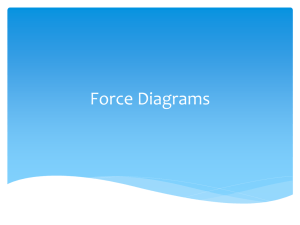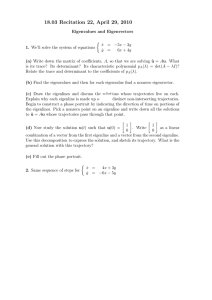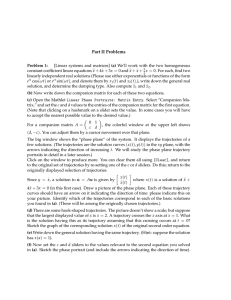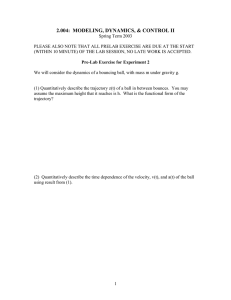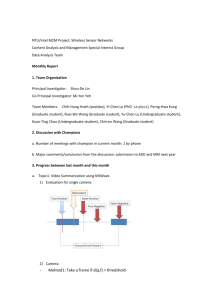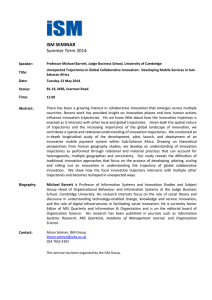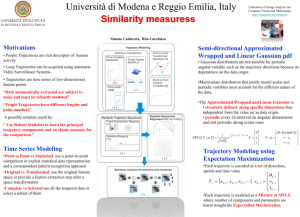Differentially Flat Trajectory Generation for a Dynamically Stable Mobile Robot Michael Shomin
advertisement
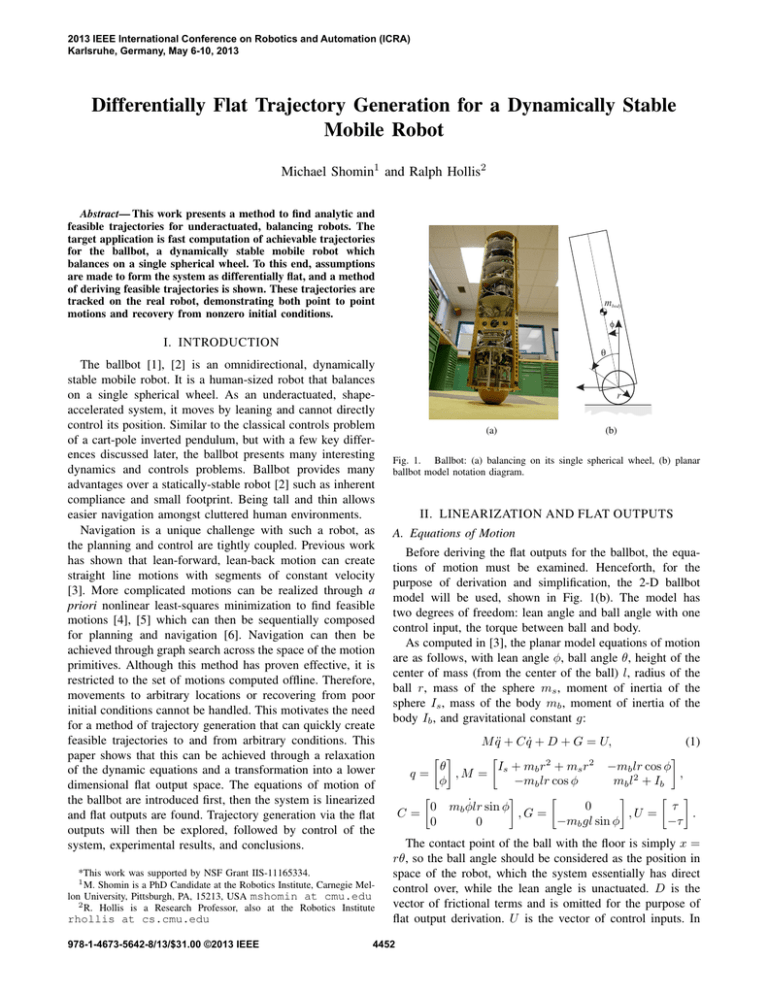
2013 IEEE International Conference on Robotics and Automation (ICRA)
Karlsruhe, Germany, May 6-10, 2013
Differentially Flat Trajectory Generation for a Dynamically Stable
Mobile Robot
Michael Shomin1 and Ralph Hollis2
1) Stra
trajectorie
static con
the floor
desired x
polynomi
boundary
Abstract— This work presents a method to find analytic and
feasible trajectories for underactuated, balancing robots. The
target application is fast computation of achievable trajectories
for the ballbot, a dynamically stable mobile robot which
balances on a single spherical wheel. To this end, assumptions
are made to form the system as differentially flat, and a method
of deriving feasible trajectories is shown. These trajectories are
tracked on the real robot, demonstrating both point to point
motions and recovery from nonzero initial conditions.
mbody
2
*This work was supported by NSF Grant IIS-11165334.
1 M. Shomin is a PhD Candidate at the Robotics Institute, Carnegie Mellon University, Pittsburgh, PA, 15213, USA mshomin at cmu.edu
2 R. Hollis is a Research Professor, also at the Robotics Institute
rhollis at cs.cmu.edu
978-1-4673-5642-8/13/$31.00 ©2013 IEEE
r
(a)
(a)
(b)
(b)
Fig. 1. (a) The ballbot balancing, (b) Planar ballbot model with ball and
configurations
shown. on its single spherical wheel, (b) planar
Fig. 1.bodyBallbot:
(a) balancing
ballbot model notation diagram.
By global change of coordinates θx! = θx − φy and θy! =
θII.
φx , the equations of motion
with the
new configuration
AND FLAT
OUTPUTS
y +LINEARIZATION
vector q ! = [θx! , θy! , φx , φy ]T has no input coupling in F ! (q ! ):
A. Equations of Motion
1 0the ballbot, the equaBefore deriving the flat outputs for
0 1
! !examined.
tions of motion must Fbe
Henceforth,
for the
(q ) =
(24)
0 0 .
purpose of derivation and simplification,
the 2-D ballbot
0 0
model will be used, shown in Fig. 1(b). The model has
The newof
forced
Euler-Lagrange
two degrees
freedom:
lean angleequations
and ball are:
angle with one
control input, the
torque
between
ball
and
body.
M ! (q ! )q̈ ! + C ! (q ! , q̇ ! )q̇ ! + G! (q ! ) = F ! (q ! )τ.
(25)
As computed in [3], the planar model equations of motion
is to be with
notedlean
thatangle
the underactuated
system
are asIt follows,
φ, ball angle θ,
heightinofEq.
the25
satisfies
all (from
the properties
of shape-accelerated
underactuated
center
of mass
the center
of the ball) l, radius
of the
systems
in Sec.
Theofexpresball systems
r, massand
of balancing
the sphere
ms , listed
moment
of II-B.
inertia
the
sions
M ! ,of
C !the
, G! body
are omitted
here dueofto inertia
lack of of
space.
sphere
Is ,for
mass
mb , moment
the
two equations
of motion
in Eq. 25 form the
body IbThe
, andlast
gravitational
constant
g:
dynamic constraint equations of the system and these equations are used
optimal
shape
M for
q̈ + the
C q̇ +
D+G
= U,trajectory planner
(1) in
Sec. III-B.
algorithm used here is Levenberg The optimization
θ
I + mb r2 +which
ms r2is a−m
φ tool for
b lr cos
widely
used
q Marquardt
=
, Malgorithm
= s (LMA),
,
φ
−minb lrleast-squares
cos φ
mb l2fitting
+ Ib and nonminimization
problems
curve
programming. The dynamic
weresimulated
linear
equations
0 was implemented
τ using
0 mb φ̇lr sin
andφthe, Goptimization
=
,U =
.
C =in MATLAB
−mSome
−τresults
0
0lsqnonlin function.
b gl sin
MATLAB’s
ofφthe planning
arecontact
presented
below.
The
point
of the ball with the floor is simply x =
rθ, so
ball angle
should
be considered
as the position in
A. the
Results
of Optimal
Shape
Trajectory Planning
space of the robot, which the system essentially has direct
This section presents a variety of desired xw (t) and yw (t)
control
over, while the lean angle is unactuated. D is the
that satisfy the conditions in Sec. III-B and the corresponding
vector
of
frictional
is omitted
of
planned
optimalterms
shapeand
trajectories,
φpxfor
(t) the
and purpose
φpy (t), which
flat output
derivation.
U
is
the
vector
of
control
inputs.
In
should be tracked to achieve them. It is important to note that
4452
the desired trajectories, xw (t) and yw (t), are trajectories of the
center of the ball and not trajectories of the system’s center of
gravity. On a flat floor, these trajectories match the trajectories
of the ball’s contact point with the floor.
1
0
Fig. 2.
color.)
S
where th
the initial
Angle (deg)
The ballbot [1], [2] is an omnidirectional, dynamically
stable mobile robot. It is a human-sized robot that balances
on a single spherical wheel. As an underactuated, shapeaccelerated system, it moves by leaning and cannot directly
control its position. Similar to the classical controls problem
of a cart-pole inverted pendulum, but with a few key differences discussed later, the ballbot presents many interesting
dynamics and controls problems. Ballbot provides many
advantages over a statically-stable robot [2] such as inherent
compliance and small footprint. Being tall and thin allows
easier navigation amongst cluttered human environments.
Navigation is a unique challenge with such a robot, as
the planning and control are tightly coupled. Previous work
has shown that lean-forward, lean-back motion can create
straight line motions with segments of constant velocity
[3]. More complicated motions can be realized through a
priori nonlinear least-squares minimization to find feasible
motions [4], [5] which can then be sequentially composed
for planning and navigation [6]. Navigation can then be
achieved through graph search across the space of the motion
primitives. Although this method has proven effective, it is
restricted to the set of motions computed offline. Therefore,
movements to arbitrary locations or recovering from poor
initial conditions cannot be handled. This motivates the need
for a method of trajectory generation that can quickly create
feasible trajectories to and from arbitrary conditions. This
paper shows that this can be achieved through a relaxation
of the dynamic equations and a transformation into a lower
dimensional flat output space. The equations of motion of
the ballbot are introduced first, then the system is linearized
and flat outputs are found. Trajectory generation via the flat
outputs will then be explored, followed by control of the
system, experimental results, and conclusions.
Linear Y Position (m)
I. INTRODUCTION
−
−
Fig
this system the only control input is torque between body and
ball. Eq. 1 yields two equations. Adding these two equations
and replacing the second equation with the result yields:
τ
0
0
0
M (q)q̈ + C (q, q̇) + G (q) =
.
(2)
0
This formulation is useful as the control input (torque)
does not appear in the second equation. The second equation
from Eq. 2 is referred to as the internal system dynamics and
is equal to zero.
B. Differential Flatness
Differential Flatness [7] is a property of some systems
that can reduce the complexity of trajectory generation [8].
In defining a flat system, the goal is to find “flat output”
variables, which are defined as functions of the state variables
and their derivatives. There are as many flat outputs as
control inputs to the system. For a flat output to be feasible,
the state variables and control inputs must have a functional
mapping from the flat outputs S and their derivatives:
S = Y (x, ẋ, ẍ, ..., x(r) )
(3)
(β)
(4)
x = A(S, Ṡ, S̈, ..., S
u = B(S, Ṡ, S̈, ..., S
)
(β+1)
).
approximation about equilibrium, i.e., sin φ ≈ φ and cos φ ≈
1. This makes the Eq. 2 become
τ = αθ̈ + (α + β)φ̈ − βφφ̇2
and
0 = (α + β)θ̈ + (α + γ + 2β)φ̈ − βφφ̇2 +
C. Flat Outputs
Given the ballbot equations of motion in Eq. 2, some
assumptions must be made to modify the equations such
that flat outputs can be defined. Previous work has been
done in finding flat outputs for a cart-pole [9] with similar
assumptions. The major difference in these systems is that
the ballbot has extra terms due to the control input being
torque between body and ball, and not just on the ball. The
force on the cart in the inverted pendulum does no virtual
work on the pole, simplifying the equations slightly, whereas
the generalized force in the planar ballbot does virtual work
on both body and ball.
To find flat outputs, the system must be linearized. Because
the robot’s lean angle is generally bounded −5◦ < φ < 5◦
in normal operation, it is reasonable to use the small angle
βgφ
,
r
(7)
with α = Iball + (mball + mbody )r2 , β = mbody rl, γ =
Ibody + mbody l2 , each constants.
Next, to further linearize the system, the term βφφ̇2 must
be assumed negligible. Intuition dictates that since φ should
be nominally zero and φ̇ should be small, this term should
be very small, as it is the product of three small quantities.
With this assumption, Eq. 6 becomes:
τ = αθ̈ + (α + β)φ̈
(8)
and Eq. 7, the internal dynamics, becomes:
r
α
r( + 1)θ̈ + (α + γ + 2β)φ̈ = gφ,
β
β
| {z }
|
{z
}
λ1
(5)
In other words, if x is vector of state variables, the functions
Y , A, and B must exist with finite r and β. If flat outputs
exist for a given system, trajectory generation may become
simpler, as trajectories of the flat output variables yield
trajectories for the state variables and the control inputs. The
flat output trajectory must simply have enough derivatives to
satisfy the mapping back to the state variables and control
inputs. In the case of a system like the planar ballbot,
there will be one flat output variable corresponding to the
one control input. A trajectory in this variable will map to
trajectories in lean angle and ball position. Therefore, if a
flat output can be found, the task of generating a feasible
trajectory will be reduced to simply finding a trajectory in the
flat output with sufficient derivatives. In the general case, the
flat output trajectories can have any basis. For the purpose
of easily satisfying boundary conditions and having finite
smooth derivatives, polynomials are used for this work.
(6)
(9)
λ2
λ1 θ̈ + λ2 φ̈ = gφ.
(10)
λ1 and λ2 are constants. With this equation, the flat output
S is defined as:
S = λ1 θ + λ2 φ,
(11)
with derivatives:
Ṡ = λ1 θ̇ + λ2 φ̇,
(12)
S̈ = λ1 θ̈ + λ2 φ̈ = gφ
(13)
from Eq. 10, and
...
S = g φ̇
S
(4)
= g φ̈.
(14)
(15)
This mapping is chosen after recognizing the relationship
between φ, θ̈, and φ̈ in Eq. 10. This gives the mapping of
the two state variables θ and φ to the flat output variable
S in Eq. 11. Four derivatives of S are shown because these
are required to get the inverse mapping to the state variables
and their derivatives present in Eqs. 6 and 7. This is also
necessary because for the flat output to be valid, there must
be a mapping to the control input τ . Because φ̈ appears in
the equation for τ , a mapping to φ̈ is required. Leaving g on
the right hand side, outside of the λ constants emphasizes
that the system is shape accelerated, meaning it’s acceleration
comes from nonzero lean angle. It should be noted that with
these four derivatives of S, there is a mapping from both the
state variables and a finite number of derivatives to S and
a mapping from S and a finite number of derivatives to the
state variables and the control input. Therefore, S is a flat
output of the linearized system in Eqs. 8 and 9. Using this
relation, trajectory generation can now be simplified.
4453
III. TRAJECTORY GENERATION
The ballbot is accelerated by its lean angle φ, but the
more important state variable in high level planning is the
ball angle θ, as it can be thought of as the global position
of the robot. From the previous section, it has been shown
that from a flat output trajectory, the feasible θ trajectory can
be found for the linearized system in Eqs. 8 and 9. In the
control law derived in the next section, it will be shown that
τ depends on the fourth derivative of S; as such S needs
to be at least C 4 for a point-to-point motion, with desired
initial and final configurations, making ten conditions. With
these constraints and the choice of a polynomial basis, a
nonic (ninth order) polynomial is needed. After constructing
this polynomial Sd from the constraints, the state variable
trajectories are simply found by solving Eqs. 11 and 13 for
θ and φ:
λ2
1
Sd − S̈d
(16)
θ∗ =
λ1
g
S̈d
φ∗ =
.
(17)
g
This means that given a smooth function in S (in this case a
nonic polynomial), a feasible trajectory in θ∗ and φ∗ can be
easily calculated which satisfies the internal system dynamics. Because there is a mapping in the opposite direction (Eq.
11), the S trajectory can be constructed with initial and final
conditions given by state variables. Fig. 2 shows an example
of a rest-to-rest motion and feasible θ trajectory that comes
out. S has been rescaled by λ1 for the purpose of comparison.
This is a rather agressive trajectory, moving the robot two
meters in three seconds. As such, a very large lean angle
is required. As can be seen from the θ output trajectory in
Fig. 2, the ball must first roll back before moving forward to
achieve that lean angle. It then overshoots and comes back
to achieve the lean back required for deceleration. The fact
that this behavior comes out naturally from the flat output
trajectory is a significant advantage of this method. The
polynomial in S was constructed from initial conditions of
θ0 = 0, θ̇0 = 0, φ0 = 0, φ̇0 = 0, φ̈0 = 0 and final conditions
θf = rxf = 2r ≈ 24 rad, θ̇f = 0, φf = 0, φ̇f = 0, φ̈f = 0.
2.5
Position (m)
2
1.5
1
Flat Output
Ball Position
0.5
0
−0.5
0
0.5
1
1.5
2
2.5
3
3.5
Time (s)
Fig. 2. Desired flat output trajectory and corresponding feasible θ trajectory.
As stated previously, the flat output trajectory is a nonic
polynomial, and in the previous example shown in Fig.
2, ten constraints were used to generate it. However, for
many cases, it may be beneficial to leave some of those
parameters free. In a quick stopping trajectory, for example,
the final position may not be important, but coming to zero
velocity quickly is important. As seen in quadrotor trajectory
generation [10], smooth, well-formed, (in the sense of the
control input) trajectories can be found by minimizing the
snap (fourth derivative of position) over the trajectory. The
intuition for this cost function comes from Flash and Hogan
[11] who found that human arm trajectories minimize jerk
(third derivative of position). The quadrotor model control
laws contained one higher derivative than the human arm
model, so instead of jerk, snap was minimized. The planar
ballbot model contains one higher derivative still: S (4) , the
snap of the flat output, which appears in the control law.
As such, the cost function used in this work finds feasible
trajectories with free parameters by minimizing S (5) , the
(5)
crackle
... of the flat output. Note also that S is proportional
to φ, so this is equivalent to minimizing the jerk of the lean
angle, which has been found empirically to produce good
trajectories in previous work [3].
Minimizing S (5) over the whole trajectory can be formulated as a quadratic program (QP), since S is simply a ninth
order polynomial:
min
cT Hc
s.t.
Ac ≤ b.
(18)
where c is a vector of the polynomial coefficients and nonfree constraints become equality contraints Ac = b in the
QP. H is a positive definite matrix and as such, the QP
can be solved in polynomial time. This allows for real time,
optimal trajectory generation online. The ballbot updates its
controller at 500 Hz, and using this formulation, the QP can
be solved in less than 1 ms, allowing for trajectory generation
in two orthoganol directions in one controller update step.
One huge advantage of the flat output trajectories is that
they can be scaled spatially and temporally since they are
simply polynomials, compared with numerical trajectories
which have no such property. This means that any safety
requirements such as a maximum lean angle can be satisfied
by lengthening the time of a trajectory, since all the derivatives of S go to zero as t goes to infinity. When temporally
rescaled, derivatives of S simply have a scale factor of
(told /tnew )k where tnew is new time length of the trajectory,
told is the original, and k is the derivative to be scaled. Note
that this scales the initial and final conditions (other than the
zero derivative) if they are nonzero. This means that the time
length of the trajectory must be known a priori if the initial
or final derivatives are nonzero. Scaling time is also useful
for numerical stability in solving the QP. Since S is a nonic
polynomial in t, t9 appears in the minimization. As such,
using unit time of 0 < t < 1 keeps the numerical solution
from going unstable.
A. Rest-to-Rest Motions
Possibly the most useful for normal navigation, rest-torest motions are trajectories which begin and end with all
flat output derivatives equal to zero. An example motion can
4454
1.6
1.4
1.2
Y(m)
1
0.8
0.6
0.4
0.2
0
−0.5
0
0.5
1
1.5
2
2.5
X(m)
Fig. 3.
MATLAB simulation of an aggressive rest to rest motion.
be seen in the 2-D simulation, shown in Fig. 3. Notice that
to achieve forward motion, the ball first must roll backwards
to achieve a positive lean angle. This simulated motion is
the same ball trajectory shown in Fig. 2. Rest-to-rest motions
were previously explored in [3] and [6]. A comparison of the
differentially flat approach to the approach in [6] can be seen
in Fig. 4. The previous approach utilized minimization of the
deviation from the nonlinear internal system dynamics. Ball
position and velocity are within 1% for the whole trajectory
while the lean angle trajectory differs by a maximum of 12%.
This difference could be attributed to the differences between
the linearized and nonlinear system. As will be shown in
Section V, this difference in negligible in practice. The key
difference between these methods is that the differentially
flat trajectory can be computed in less that 1 ms, allowing
for online generation, unlike nonlinear minimization which
must be done offline.
0.6
0.4
xnl (m)
v (m/s)
nl
x
0.2
df
(m)
vdf (m/s)
0
−0.2
0
1
2
3
4
clude recovering from an outer loop controller going unstable
or significant disturbances. Generating a feasible trajectory
in a single controller time step before applying torque to
recover allows for feasible feedforward terms. This means
less vulnerability to higher order modes becoming excited.
One current drawback of the method is that the length of
time the trajectory will take must be known a prior to satisfy
the initial conditions. In practice, it has been found that
trajectories of 4 s or less can recover from any reasonable
condition without exiting the safe domain of the balancer.
Possible better solutions will be discussed in Section VI. In
situations when recovery is important but the final position
is not, the constraints on the final ball angle are left free.
This is a significant advantage of the QP formulation, as it
can still construct the polynomial within one time step, but
also find the best smooth path that minimizes lean angle jerk
without regard to final location.
IV. CONTROL
A. Inverse Dynamics Control
Using the flat output formulation, it is reasonably straightforward to derive an inverse dynamics control law. The
equation for feedforward torque was shown in Section II to
show differential flatness. From the external system dynamics
(Eq. 6), the control input for a given desired state is
τ = αθ̈ + (α + β cos φ)φ̈ − β φ̇2 sin φ.
(19)
Although the linearized version of the internal dynamics was
used to derive the flat outputs, the nonlinear version is used
here because as much information as is known about the
system should be used to get the control input. From [9],
the feedback terms of the control law can be wrapped into
φ̈, replaced with φ̈ = νg where ν = gS (4) + Ke . gS (4) is the
original feedforward term and Ke incorporates P feedback.
The vector of errors in the flat outputs is e, and K is vector
of gains. This becomes an inverse dynamic controller with
feedforward terms on θ̈ and φ, φ̇,φ̈, and feedback on θ, θ̇,φ,
and φ̇. Although this controller showed good performance in
MATLAB simulation, it was not tested on the robot, as will
be discussed in Section VII.
2
B. Cascaded PID
1
Currently, the ballbot uses an inner and outer loop control
scheme as discussed extensively in [6]. A PID controller
is run on the desired lean angle, with an outer loop PD
controller for trajectory following. This method has the
advantage of placing limits on lean angle and ensuring that
as long as the balancing controller is stable within the lean
angle limits, the robot will not fall over. Although this may
not yield the same performance as an inverse dynamics or
LQR controller, having an inner loop balancer is a more
robust approach as substantiated by experiments in [12]. As
such, this method of control is utilized to test the feasibility
of the generated trajectories. An inner loop balancer has the
notion built in of staying upright as the most mission-critical
task.
0
φnl (deg)
−1
−2
0
φdf (deg)
1
2
3
4
Time (s)
Fig. 4. Comparison of Differentially Flat (df) Trajectory with corresponding
trajectory found via offline nonlinear (nl) minimization
B. Arbitrary Motion and Free Constraints
Differentially flat trajectory generation scales to more
complex situations than rest-to-rest motions. Examples in-
4455
V. RESULTS
A. Experimental Setup
Testing of the trajectories generated via the methods
presented was done on the ballbot. The system has a lowlevel computer running the QNX real-time operating system
controlling the inner-loop balancer, driving the motors and
reading data from the IMU. The four motors drive the ball
via an inverse mouse-ball drive [1].
Lean angles are commanded via socket communication
from another onboard computer, running Ubuntu Linux. This
higher level computer handles all tasks that are not realtime critical. For this work, it was used for generating the
trajectories and communicating with a laptop to start and
stop trajectories. This machine runs ROS [13] for communication between processes; ease of visualization; and in other
applications, mapping and localization.
For the purpose of visualizing the trajectories, a strip of
LEDs was attached vertically to the side of the robot. Each
of the 45 exposed RGB LEDS can be commanded to a 7bit value via an I 2 C bus. A ROS node sends message via
serial to an Arduino microcontroller which then commands
the LED chain. By taking a long-exposure photograph, a
trail of the robot can be seen throughout the trajectory. This
technique has been used for tracing robot paths before [14],
[15] and has proven effective as a tool to visualize a dynamic
trajectory.
B. Rest-to-Rest Motion
Rest-ro-rest motions for distances of 0.5 m to 2.0 m were
run with the robot. Time was varied to affect the maximum
lean angle achieved in the trajectory. Maximum angles from
1.2◦ to 5◦ were achieved. Examples of this motion can be
seen in the attached video. A characteristic trajectory can be
seen in Fig. 5 with the corresponding tracking data in Fig.
6(a). In Fig. 5, the LEDs on the robot produce light trails
and pulse brightly at 3 Hz. The pulses transition from red at
the beginning of the trajectory to green at the end. Of note
is the significant lean forward and lean back behavior at the
start and end. The necessity to roll the ball backward to lean
forward and vice versa can also be seen from this image.
The maximum angle achieved in this trajectory is over 5◦ ,
which corresponds to an instantaneous acceleration of over
2 m/s2 . This is a significant lean angle for the ballbot.
All of the trajectories attempted were run open loop,
using only the feedforward lean angle for the balancer. This
was done simply to show this method is a feasible means
to create ballbot trajectories. This also allowed a look at
how good feedforward-only performance can be. Feedback
on the lean angle can also produce discontinuities, as a P
term on position will give a discontinuity at the beginning
of a trajectory if there is any deviation from the starting
condition. Despite the lack of feedback, the tracking is very
acceptable, which shows that the trajectories are certainly
feasible. For the trajectory shown in Fig. 6(a), the maximum
velocity tracking error is 15% with the trajectory slightly
undershooting, but ending 10% short of the goal. This error
Fig. 5. Long exposure photograph of rest-to-rest motion with a 5◦ lean.
LED pulses are at 3 Hz with continuous low level orange light. A flash was
used at approximately 1.5 s to illuminate the robot.
could be significantly reduced with feedback in the future,
possibly with a variant of the controller demonstrated in the
past [3].
C. Recovery Trajectories
Feasibility of recovery trajectories was accessed by testing
recovery from both an initial lean angle and an initial
velocity. A successful recovery from a 2◦ lean angle can
be seen in Fig 6(b). The lean angle was slowly ramped up
to 2◦ while the robot was held in place. The robot was let go,
and it began to accelerate. After being let go, the trajectory
planner generated a stopping trajectory and executed it. This
has been attempted 6 times, all successful recoveries. This
motion can be seen in the attached video. Recovery from
initial velocity was also tested by pushing the robot and
generating a stopping trajectory. This was also successful
in bringing the robot safely to a stop from initial velocities
up to 1 m/s.
This recovery motion can be compared to an outer-loop
station keeping controller or simply the balancing controller
trying to achieve a 0◦ lean angle from the initial offset.
Unfortunately, even with soft gains, the experimental system
has not been able to recover stably by simply using the
balancer. As such, this trajectory-based method of recovery is
not only feasible, but also very useful, as there isn’t another
good option for these scenarios.
VI. CONCLUSIONS
A method of fast, analytic trajectory generation for dynamically stable balancing robots has been presented. Relaxing
the equations of motion to form a differentially flat system allows for analytic generation of feasible trajectories. Furthermore, the method has been extended to use free constraints
4456
5
0
−5
−10
0
1
2
3
1.5
Ball Position (m)
Ball Velocity (m/s)
Lean Angle (deg)
10
1
0.5
0
−0.5
0
1
2
Time (s)
3
1.5
1
0.5
0
−0.5
0
1
Time (s)
2
3
Time (s)
2
1
0
−1
−2
0
1
2
3
Time (s)
0.6
Ball Position (m)
3
Ball Velocity (m/s)
Lean Angle (deg)
(a) Rest-to-rest motion from x = 0 to x = 1m in 4s. Max lean angle is approximately 5 degrees.
0.4
0.2
0
−0.2
0
1
2
3
0.8
0.6
0.4
0.2
0
−0.2
0
Time (s)
1
2
3
Time (s)
(b) Recover from an initial lean angle of 2 degrees. Recovery takes 4 seconds and
Fig. 6. Lean angle, velocity, and position data from a rest-to-rest motion and a recover motion. Desired trajectories are shown in dashed black with the
colored lines showing actual data. Both experiments were done open loop with only feedforward lean angles given to the balancing controller.
for recovering from poor initial conditions. This method was
experimentally verified with the ballbot, a single-wheeled
balancing system. The derivation of this technique also confirmed some empirically-found notions from previous work
[3]. These include using a nonic polynomial for trajectories
and minimizing the jerk of lean angle.
VII. FUTURE WORK
The method can be extended with closed loop position
feedback. The possibility of solving the QP iteratively can
also be explored in an attempt to avoid specifying a time
length before generating trajectories. This work could also be
extended to piecing trajectories together to form more complicated paths. Planning could be done between keyframes on
the path with lean angle jerk minimized over the total path.
Finally, the trajectories presented could be used as motion
primitives. Since they are so quick to compute, the set of
motion primitives could be updated dynamically to adjust to
the needs of the system.
ACKNOWLEDGMENTS
This work was supported in part by NSF grant IIS11165334. The authors thank Umashankar Nagarajan and
Paul Vernaza for their assistance in running experiments.
R EFERENCES
[1] T. Lauwers, G. Kantor, and R. Hollis. A dynamically stable singlewheeled mobile robot with inverse mouse-ball drive. In Robotics and
Automation, 2006. ICRA 2006. Proceedings 2006 IEEE International
Conference on, pages 2884 –2889, may 2006.
[2] R. Hollis. Ballbots. Scientific American, 18:72–78, October 2008.
[3] U. Nagarajan, G. Kantor, and R. Hollis. Trajectory planning and control of an underactuated dynamically stable single spherical wheeled
mobile robot. In Robotics and Automation, 2009. ICRA ’09. IEEE
International Conference on, pages 3743 –3748, may 2009.
[4] U. Nagarajan. Dynamic constraint-based optimal shape trajectory
planner for shape-accelerated underactuated balancing systems. In
Proceedings of 2010 Robotics: Science and Systems, June 2010.
[5] U. Nagarajan, G. Kantor, and R. Hollis. Hybrid control for navigation
of shape-accelerated underactuated balancing systems. In CDC’10,
pages 3566–3571, 2010.
[6] U. Nagarajan, G. Kantor, and R. Hollis. Integrated planning and
control for graceful navigation of integrated planning and control
for graceful navigation of shape-accelerated underactuated balancing
mobile robots. In Robotics and Automation, 2012. ICRA ’12. IEEE
International Conference on, page to appear, may 2012.
[7] M. Fliess, J. Lévine, and P. Rouchon. Flatness and defect of nonlinear
systems: Introductory theory and examples. International Journal of
Control, 61:1327–1361, 1995.
[8] H. Sira-Ramı́rez and S. Agrawal. Differentially Flat Systems. Control
Engineering. Taylor & Francis, 2004.
[9] A. Mansour and H. Jerbi. An exact differential flatness control for a
non minimum phase model of an inverted pendulum. In Proceedings
of the 2009 Third Asia International Conference on Modelling &
Simulation, AMS ’09, pages 465–469, Washington, DC, USA, 2009.
IEEE Computer Society.
[10] D. Mellinger and V. Kumar. Minimum snap trajectory generation
and control for quadrotors. In Proceedings of the IEEE International
Conference on Robotics and Automation (ICRA), May 2011.
[11] T. Flash and N. Hogans. The coordination of arm movements:
An experimentally confirmed mathematical model. JOURNAL OF
NEUROSCIENCE, 5:1688–1703, 1985.
[12] U. Nagarajan, B. Kim, and R. Hollis. Planning in high-dimensional
shape space for a single-wheeled balancing mobile robot with arms.
In Proceedings of the IEEE International Conference on Robotics and
Automation (ICRA), pages 130–135, 2012.
[13] M. Quigley, K. Conley, B. Gerkey, J. Faust, T. Foote, J. Leibs,
R. Wheeler, and A. Ng. Ros: an open-source robot operating system.
In ICRA Workshop on Open Source Software, 2009.
[14] S. Kuznetsov, E. Paulos, and M. Gross. Wallbots: interactive wallcrawling robots in the hands of public artists and political activists.
In Proceedings of the 8th ACM Conference on Designing Interactive
Systems, DIS ’10, pages 208–217, New York, NY, USA, 2010. ACM.
[15] M. Shomin and J. Fiene. Teaching manipulator kinematics by painting
with light. ASME Conference Proceedings, 2011(54839):677–683,
2011.
4457
